Top 10 Best Card Games to Play: Are you a fan of card games? Whether you are looking for a new game to play or are just curious about the latest and greatest in the world of card games, we have got you covered. In this post, we have compiled a list of the top 10 best card games to play online in 2024. From Voice of Cards Gameplay to Marvel Snap and Reigns, these games offer something for everyone. We will take you through each game’s unique features so that you can decide which one is perfect for your taste. So, without further ado, let’s dive into the exciting world of card games.
Best Card Games to Play Online in 2024
Contents
Are you looking to discover some new and exciting online card games in 2024? Our list of the ‘Top 10 Best Card Games to Play Online‘ is here to help! Featuring popular titles such as Exploding Kittens and Magic: The Gathering, these games cater to players of all ages and skill levels. Whether you’re a fan of multiplayer gameplay or prefer deck-building games, there’s something for everyone on this list. So why wait? Grab your favorite deck of cards and start playing today!

If you’re looking to choose a card game that is popular in India and ideal for playing with friends and family during gatherings and special occasions, here are the top 10 options:
| Sr. No. | Card Game | Description |
|---|---|---|
| 1 | Rummy | A popular and simple card game known for its widespread popularity. |
| 2 | Poker | A strategic game involving skill and bluffing, with a significant following worldwide and in India. |
| 3 | Teen Patti | Also known as Indian Poker, it is a traditional card game requiring luck and skill, commonly played at social gatherings and festivals. |
| 4 | Three-two-five | A captivating game played by three players, known for its strategic gameplay and unique deck composition of 30 cards. |
| 5 | Blackjack | A thrilling casino card game where players aim to reach a hand value of 21 without going over, gaining popularity in India. |
| 6 | Call Break | A trick-taking card game widely enjoyed in India, involving bidding and strategically winning a predetermined number of tricks. |
| 7 | Satte Pe Satta | Similar to the Western game of Sevens, players aim to be the first to empty their hands by shedding cards. |
| 8 | Donkey | A fun and light-hearted game where players try to avoid being the last one left with cards in their hands. |
| 9 | Bluff | Also known as Cheat, it requires players to deceive and outwit each other by playing cards facedown while trying to guess the true value. |
| 10 | Mendikot | Originating from Nepal and gaining popularity in India, it is a trick-taking game involving partnerships and strategic card play. |
These card games offer a range of options suited to different preferences and skill levels, ensuring a memorable and enjoyable experience with friends and family.
Check also: How to Play Free Fire Game Online
Rummy
Rummy holds the esteemed position of being one of the most beloved and highly regarded card games in India. Its ability to captivate and entertain has spanned centuries, and with the advent of online platforms, even millennials have enthusiastically embraced this game. Referred to as paplu as well, rummy’s appeal lies in its simplicity and fast-paced nature. Even beginners can swiftly grasp the rules and partake in cash games after gaining some experience through practice matches. Success in rummy necessitates analytical thinking and reasoning abilities.
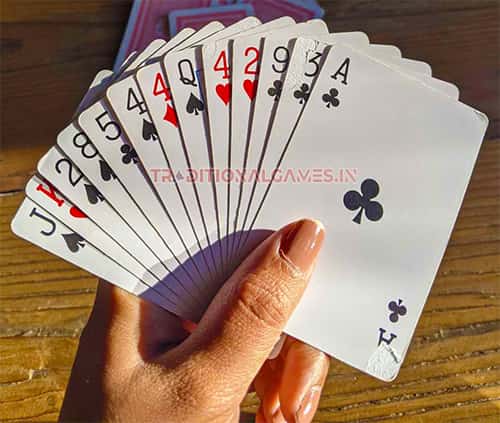
In the present day, online rummy reigns supreme as the premier skill game across the country. Numerous rummy platforms on the internet offer daily cash games and tournaments through dedicated mobile applications. By participating in these contests, players have the opportunity to secure real money prizes.
How to Play Rummy?
Rummy is a multiplayer card game played with 2 to 6 players, using one or two standard decks of cards along with a Joker. The deck(s) contain 53 cards each. Jokers in rummy come in two types: printed Jokers and wild Jokers. At the beginning of the game, each player is dealt 13 cards one at a time. The remaining cards form two decks: the closed deck (face down) and the open deck (face up).
The objective of the game is to create sequences and sets using the 13 cards in hand. The rummy rules state that there must be at least two sequences, and one of them must be a pure sequence. Let’s understand the concepts of sequences and sets:
Sequences: A sequence is a combination of three or more consecutive cards of the same suit. In rummy, there are two types of sequences:
- Pure sequence: It consists of three or more consecutive cards of the same suit, without any Joker. For example, J♦-Q♦-K♦ and A♣-2♣-3♣.
- Impure sequence: It comprises two or more consecutive cards of the same suit, along with a Joker. For example, 5♥-6♥-8♠ (8♠ acts as a wild Joker) and 10♠-J♠-Q♠-PJ (printed Joker).
Sets: A set is a group of three or four cards of the same rank/value but different suits. Jokers can also be used to form a set. For example, 5♣-5♦-5♠ and K♥-K♣-K♠-K♦.
Here’s an example of a valid declaration:
| Pure Sequence | Impure Sequence | Set 1 | Set 2 |
|---|---|---|---|
| 4♣-5♣-6♣ | 9♠-10♠-J♠-PJ | 2♣-2♥-2♠ | Q♠-Q♦-9♥ |
In rummy, the cards are ranked from high to low: A, K, Q, J, 10, 9, 8, 7, 6, 5, 4, 3, 2. Face cards (K, Q, J) and Aces are worth 10 points each, while numbered cards hold their face values. The winner of the game obtains zero points.
These rules form the basis of rummy gameplay, and players aim to strategize and form valid sequences and sets while minimizing their point tally to emerge victorious.
How To Play Pooparikka Varugirom Game? Rules & Facts
How to Win in Rummy (Best Tips & Tricks)
Here are some simplified bullet points regarding winning strategies in rummy:
- Understand the game rules and practice before playing cash games.
- Aim to create a pure sequence as a priority for a valid declaration.
- Focus on creating a second sequence, which can be pure or impure, after forming the first sequence.
- Discard high-value cards that are difficult to meld early on to minimize points and potential losses.
- Pay attention to your opponents’ moves, especially if they pick cards from the open deck.
- Avoid discarding cards that could potentially benefit your opponents and improve their chances of winning.
Variations of Rummy
Rummy game is offered in three different formats, each with a similar objective but varying gameplay. Here are the details of each format:
- 10 Cards Rummy: This format involves playing the game with a deck of 10 cards. The objective remains the same, which is to create valid sequences and sets. However, this format is less common compared to the others.
- 13 Cards Rummy: This is the most popular format of rummy. Players are dealt 13 cards each, and they strive to form valid sequences and sets. Various variants and sub-formats exist within the 13 cards rummy format.
- Points Rummy: In this variant, players compete for points, which have a predetermined rupee value in cash games. The player who declares with zero points first wins the game. Cash game winnings are calculated by multiplying the sum of opponents’ points by the rupee value assigned to each point.
- Deals Rummy: The game is played for a fixed number of deals. At the beginning of the game, players receive an equal number of chips. The winner of each deal obtains chips from the losing players based on their points. The player with the highest number of chips at the end of the final deal emerges as the winner of the game.
- Pool Rummy: This format has two variations: 101 pool and 201 pool. In 101 pool, players aim to avoid reaching 101 points, while in 201 pool, the target is to stay below 201 points. Players who reach the predetermined point limit get eliminated from the game. The player who remains without reaching the limit is declared the winner.
- 21 Cards Rummy: This format involves playing the game with a deck of 21 cards. It is less commonly played compared to the 13 cards format, and the gameplay and rules differ accordingly.
These different rummy formats offer players various ways to enjoy the game and compete against each other. Choose the format that suits your preference and enjoy the thrilling experience of playing rummy.
Mangatha Card Game Of Karnataka
Poker
Lately, poker has gained significant attention in India, largely due to its popularity in the Western world and its portrayal in Hollywood movies. As a casino game, poker demands emotional control and strategic thinking, attracting seasoned card game players.
Poker offers an abundance of enjoyment and entertainment. To play and succeed in the game, players should have a fundamental understanding of hand rankings and betting. In poker, a standard hand consists of five cards, and the rankings from highest to lowest are as follows:
- Royal Flush: A, K, Q, J, 10 of the same suit.
- Straight Flush: Any five cards in sequential order of the same suit.
- Four of a Kind: Four cards of the same rank and one unrelated card.
- Full House: Three cards of the same rank combined with a pair of cards of another rank.
- Flush: Any five cards of the same suit, not in sequential order.
- Straight: Five cards in sequential order, not of the same suit.
- Three of a Kind: Three cards of the same rank and two unrelated cards.
- Two Pair: Two sets of two cards of the same rank and one unrelated card.
- One Pair: Two cards of the same rank and three unrelated cards.
- High Card: When a player’s hand does not form any of the above combinations, the highest-ranking card in their hand determines the value.
Understanding these hand rankings is crucial for making informed decisions during the game. With practice and strategy, players can increase their chances of winning and elevate their poker skills.
Why Is Poker So Popular Online?
Online poker’s popularity can be attributed to its accessibility, competitive nature, and potential for big rewards. With various game modes and tournaments available, players can choose their preferred level of challenge. Additionally, the social aspect of playing with people from around the world makes it a favorite among those who enjoy a strategic challenge.
Check More on Wikipedia
How to Play Poker?
To play poker, follow these basic steps:
- Understand the Hand Rankings: Familiarize yourself with the different hand rankings, from the highest (Royal Flush) to the lowest (High Card). This knowledge is essential in determining the value of your hand and making strategic decisions.
- Learn the Game Format: Poker can be played in various formats, such as Texas Hold’em, Omaha, or Seven-Card Stud. Choose a format and become familiar with its specific rules, including the number of cards dealt, the betting structure, and the hand ranking variations.
- Get to Know the Game Components: Poker is typically played with a standard 52-card deck, although some variations may include jokers. Each player is dealt a certain number of cards, depending on the game format, and the goal is to create the best hand possible.
- Understand the Betting Rounds: Poker involves betting rounds where players can either bet, raise, call (match the previous bet), or fold (withdraw from the hand). The specific betting rules can vary depending on the format being played.
- Start with Blinds or Ante: In many poker games, such as Texas Hold’em, the two players to the left of the dealer post small and big blinds before the cards are dealt. These mandatory bets ensure there is money in the pot to play for.
- Receive Your Cards: After the blinds are posted, each player is dealt their initial cards face-down (hole cards). The number of cards and the order of dealing depend on the game variant.
- Make Pre-Flop Decisions: In games like Texas Hold’em, players make decisions based on their hole cards. This includes checking (not betting when no one else has), betting, raising, or folding based on the strength of their hand.
- See the Flop, Turn, and River: In certain formats like Texas Hold’em, community cards are dealt face-up on the table, known as the flop (three cards), turn (one card), and river (one card). These cards can be used by all players to make the best hand.
- Place Bets and Make Decisions: As the community cards are revealed, betting rounds occur, and players can continue to bet, raise, call, or fold based on their hand strength and their assessment of their opponents’ hands.
- Showdown: Once all betting rounds are complete, remaining players reveal their hands to determine the winner. The player with the highest-ranking hand, according to the established hand rankings, takes the pot.
- Learn and Adapt Strategies: Poker involves a mix of skill, strategy, and psychology. Study different strategies, such as bluffing, position play, and reading opponents, to improve your gameplay and make informed decisions.
Remember, poker is a game of skill and luck. It takes practice and experience to become proficient. Learning the rules and practicing with friends or in online games can help you improve your understanding and abilities in poker.
Google Play Today Redeem Code for today
How to Win in Poker (Best Tips & Tricks)
- Mindset: Determine your goals before playing poker. Decide if you want to focus on having fun or if winning is your main objective. Striking a balance between enjoyment and competitiveness can enhance your overall experience.
- Starting Hands: The choice of your starting hand is crucial. Understand the value of different hand combinations and learn which hands have the potential to be strong. Playing with strong starting hands increases your chances of success.
- Maintain Composure: It’s essential to control your emotions during a poker game. Displaying emotions can give away information to your opponents, potentially compromising your strategy. Maintain a calm and composed demeanor or take breaks when needed to refocus and play your best game.
- Assess Your Hand: Analyze the strength of your hand after the cards are dealt. If you have a weak hand, consider folding early in the game to minimize losses. Avoid the temptation to play every hand and be selective in your decisions.
Remember, poker is a game of skill and strategy. With practice and experience, you can improve your decision-making abilities and increase your chances of success at the poker table.
Variations of Poker
There are numerous variations of poker, each with its own unique rules and gameplay. Here are some popular variations:
- Texas Hold’em: This is the most widely played form of poker, both in casinos and online. Each player receives two private cards (hole cards), and five community cards are dealt face-up on the table. Players use their hole cards and the community cards to create the best five-card hand.
- Omaha: Similar to Texas Hold’em, players in Omaha receive four hole cards instead of two. However, the hand rankings and the requirement to use precisely two hole cards and three community cards to form a hand make this variation distinct.
- Seven-Card Stud: In this classic variation, players receive a combination of face-up and face-down cards over multiple betting rounds. Each player aims to create the best five-card hand out of the seven cards they are dealt.
- Five-Card Draw: This is a simple and straightforward form of poker. Each player is dealt five private cards and can choose to discard and replace any number of cards in an attempt to improve their hand.
- Razz: Razz is a lowball poker game, where the goal is to create the lowest possible hand. The hand rankings and rules are reversed compared to traditional poker, with the lowest-ranked hand winning the pot.
- Caribbean Stud Poker: In this casino-based game, players compete against the house rather than each other. Each player receives five cards, and the goal is to have a higher-ranked hand than the dealer.
- Pai Gow Poker: This game combines elements of poker and traditional Chinese game of Pai Gow. Players receive seven cards and must create two hands, one with five cards and one with two cards, that are stronger than the dealer’s hands.
- Badugi: Badugi is a draw poker variant where the objective is to have the lowest four-card hand with four different suits. The game features three drawing rounds and a unique hand ranking system.
These are just a few examples of the many variations of poker. Each variation offers its own set of rules, strategies, and excitement, providing players with diverse options to explore and enjoy the game of poker.
Teen Patti
Teen Patti, meaning “three cards” in Hindi, is a popular Indian card game that draws inspiration from the British game of 3-card brag. It is often referred to as Indian poker due to its resemblance to American poker. The game involves betting and the distribution of cards among the players. Teen Patti has gained significant popularity across various regions of India, becoming a craze among card game enthusiasts. It has even been featured in several Bollywood movies, including the film “Teen Patti,” which centers around the game itself.

In Teen Patti, the ranking of card groups from high to low is as follows:
- Trio or Trail: Three cards of the same rank but different suits. The highest trio is three Aces (A♠-A♥-A♦), and the lowest is three Twos (2♣-2♥-2♠).
- Straight Run: Three consecutive cards of the same suit. The highest straight run is A♠-2♠-3♠, and the lowest is 4♣-3♣-2♣.
- Normal Run: Three consecutive cards of different suits. For example, A♥-2♠-3♣ or 5♦-6♥-7♠.
- Color/Flush: All three cards in the hand are from the same suit. If two players have a flush, the player with the highest card in the flush wins.
- Pair: Two cards of the same rank. In the case of two pairs, the player with the highest value pair wins. For example, A♠-A♦-Q♣ or 5♥-5♣-8♠.
- High Card: If no player has any of the above combinations, the player with the highest card becomes the winner.
These rankings determine the hierarchy of hands in Teen Patti, with the trio being the highest-ranking combination and the high card being the lowest.
How to Play Teen Patti?
To play Teen Patti, follow these steps:
- Players and the Dealer: The game is typically played with 3 to 6 players, and one player acts as the dealer.
- Betting: Each player places an agreed-upon initial bet into the pot to start the game.
- Dealing of Cards: The dealer shuffles a standard deck of 52 cards and deals three cards face-down to each player, one at a time, in a clockwise direction.
- Gameplay: The game proceeds in rounds, with players taking turns clockwise. During their turn, players have the following options:
- Chaal: The player can place a bet into the pot, which should be equal to the current bet amount or higher.
- Pack/Fold: The player can choose to fold and not participate in the current round. They lose any bets they have placed previously.
- Show: This option is available when only two players remain in the game. The two players reveal their cards, and the player with the higher-ranking hand wins the pot.
- Side Pots: If a player decides to chaal but doesn’t match the current bet amount, they can choose to participate in a side pot. This side pot is separate from the main pot and is contested only by players who contribute to it.
- Ranking of Hands: At the end of the betting rounds, the players who haven’t folded reveal their cards. The player with the highest-ranking hand according to the Teen Patti hand rankings (trio, straight run, normal run, flush, pair, or high card) wins the pot.
- Next Round: The dealer position rotates to the next player, and the game continues with new bets and cards dealt.
- Winning and Settling: The game continues until only one player remains or until the agreed-upon number of rounds is completed. The final winner receives the entire pot collected throughout the game.
Remember, Teen Patti involves betting, and it’s important to adhere to responsible gambling practices and agreed-upon betting limits to ensure an enjoyable experience for all players involved.
Teen Patti Multiplayer, Online, Rules, Gameplay, Trail and How to Download Apk?
How to Win in Teen Patti Game (Best Tips & Tricks)
Indeed, while luck plays a significant role in Teen Patti, players can employ strategies and techniques to improve their chances of winning. Here are some tips and tricks:
- Agree on Stakes: Ensure that the betting stakes are agreeable to all players involved. Starting with lower-value bets and gradually increasing them allows everyone to participate comfortably.
- Maintain a Neutral Demeanor: Similar to poker, it’s essential to keep your emotions in check during the game. Avoid displaying any expressions or emotions that may give away the strength of your hand. Instead, observe and analyze your opponents’ behavior and reactions.
- Moderate Betting with Good Cards: If you are dealt strong cards, avoid immediately placing a large bet. Doing so may cause players with weaker hands to fold, resulting in a missed opportunity to win a larger pot. Instead, consider moderate betting to entice others to stay in the game.
- Consider Playing Blind: Opting to play blind, especially in the initial rounds, can create an aura of confidence and unpredictability. Many inexperienced players become restless and tend to reveal their cards early. By playing blind, you may intimidate opponents, causing them to fold prematurely.
Remember, while these strategies can enhance your chances, there is always an element of uncertainty in Teen Patti. It’s important to exercise responsible gambling practices and approach the game with a balanced mindset.
Variations of Teen Patti
In addition to the standard version of Teen Patti, there are various popular variations that add unique twists to the game. Here are some noteworthy variations:
- Mufliss: The hand rankings are reversed in this variation. The lowest-ranking hand becomes the highest, and the highest-ranking hand becomes the lowest. For example, the highest-ranking hand is now a high card, and the lowest-ranking hand is a trio.
- Rotating Jokers: At the beginning of the game, a card is chosen as the Joker. Any player who receives this card can use it to form combinations in their hand. It adds an element of unpredictability and strategy to the game.
- AK47: In this variation, aces, kings, fours, and sevens are designated as Jokers. These cards can be used as substitutes for any other card to complete combinations. The presence of multiple Jokers increases the chances of creating stronger hands.
These variations introduce new dynamics and strategies to the game of Teen Patti, offering players exciting and unique game play experiences.
How To Play Thirudan Police Games?
Three-Two-Five ( 3 2 5)
Three-two-five (3-2-5) is a trick-taking card game that is widely enjoyed in India, Nepal, and Pakistan. It is commonly referred to by various names such as 2-3-5, 5-3-2, and teen-do-panch in Hindi. The game is relatively simpler and is often played by children, utilizing a deck of 30 cards. Its entertaining nature has led to the development of a modified version known as 3-5-8, also called Sergeant Major.
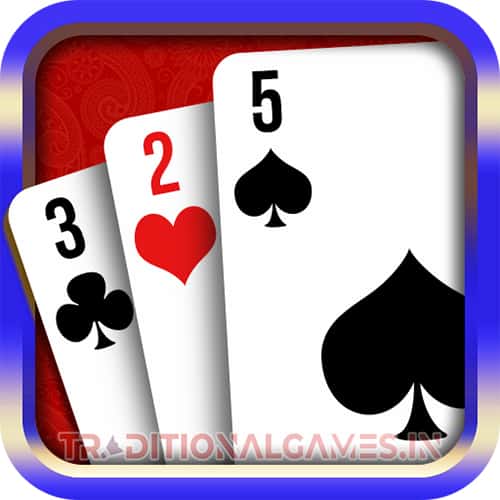
How to Play Three-Two-Five?
- Game is played by 3 players, dealing is counterclockwise.
- 30-card deck created from a standard 52-card deck.
- Cards removed: 2, 3, 4, 5, 6, two 7s.
- Seven of Hearts (7♥) and Seven of Spades (7♠) are kept.
- Card rankings: A, K, Q, J, 10, 9, 8, (7).
- Minimum number of tricks each player must win: Dealer (2), Right player (5), Last player (3).
Dealing:
- 5, 3, and 2 cards drawn to determine dealer and initial trick requirements.
- Dealer shuffles and deals 5 cards to each player.
- Right player chooses trump suit.
- Dealer deals 3 cards, then 2 cards to make a total of 10 cards for each player.
Play:
- Game starts with right player playing a card.
- Other players must play higher value cards from the same suit if possible.
- If players don’t have a card from the same suit, they can play trump cards.
- Highest trump card played wins the trick.
- After 10 tricks, each player checks if they won the required number of tricks.
Winning Conditions:
- If all players have won the required number of tricks, the game continues.
- If a player fails to win their quota, highest trick winner takes a card from their hand.
- Second highest trick winner gives away an unwanted card.
- Card exchange is done privately between players.
Game Continuation:
- The 3-2-5 game does not have an end.
- Scoring can be used to determine the winner by assigning points for each trick won.
How to Win in Three two five Card Game?
Selecting a trump suit based on the suit with the highest number of cards in your hand can indeed be a useful strategy in the 3-2-5 game. By doing so, you increase your chances of having stronger cards in that suit and potentially winning more tricks.
Here’s a summary of the trick to beat your opponents:
- Analyze your hand: Assess the number of cards you have in each suit.
- Identify the suit with the highest number of cards: Determine which suit has the most cards in your hand.
- Select that suit as the trump suit: Choose the suit with the highest card count to be the trump suit for the round.
- Play strategically: Utilize your stronger cards in the trump suit to win tricks and gain an advantage over your opponents.
This strategy allows you to maximize the potential of your hand and increase your winning chances by leveraging the strength of the suit with the highest card count. However, keep in mind that other factors, such as the specific card rankings and the actions of your opponents, should also be considered to make the best decisions during gameplay.
Variations of Three-Two-Five
Here are a few variations of the 3-2-5 game:
- No Trump, No Deal: Players who do not have any trump cards can choose to reveal their hand and quit the game. This adds a strategic element to the game, as players need to assess their hand and decide whether it’s worth continuing without any trump cards.
- Ten Tricks Bonus: If a player successfully wins all 10 tricks in a round, they receive a bonus of 5 points. Additionally, the player gets the opportunity to select a specific number of cards from their opponents’ hands, potentially improving their own hand for the next round.
- 7-8 (Saath-Aath): This variation is similar to 3-2-5 and is popular in India. It uses a 30-card deck with the same card rankings. However, regardless of the chosen trump suit, the two sevens are always considered the highest cards of the trump suit.
These variations introduce additional strategic decisions and rewards for certain achievements in the game, providing a fresh twist to the traditional 3-2-5 gameplay.
Blackjack
Blackjack, also known as twenty-one, is a popular casino game played worldwide. It is a comparing card game between a player and a dealer, where the goal is to reach a hand value closer to 21 than the dealer’s hand without exceeding it. The game has gained significant popularity and has been featured in numerous Hollywood movies, including several James Bond films.

The Basics of Blackjack
In blackjack, each card has a specific value. Numbered cards are worth their face value, face cards (King, Queen, Jack) are worth 10, and an Ace can be worth either 1 or 11, depending on the player’s choice. The game begins with the player receiving two cards, both face-up, while the dealer receives one card face-up and one card face-down.
Gameplay
After receiving the initial cards, the player has several options:
- Hit: Request additional cards to improve their hand’s total value.
- Stand: Decline any more cards and proceed with the current hand.
- Double Down: Double the initial bet, take one more card, and then stand.
- Split: If the player’s first two cards have the same value, they can split them into two separate hands, each with its own bet.
- Insurance: If the dealer’s face-up card is an Ace, players have the option to make an additional side bet called “insurance” to protect themselves against the possibility of the dealer having blackjack.
The dealer must follow specific rules when playing their hand. Usually, the dealer will hit until their hand value reaches 17 or higher, and then they will stand.
Winning and Losing
The objective of blackjack is to have a hand value closer to 21 than the dealer without exceeding 21. If a player’s hand exceeds 21, it results in a “bust,” and they lose their bet. If the player’s hand value is less than or equal to 21 and higher than the dealer’s hand, they win. If the dealer’s hand value is higher, the player loses. When the player’s hand and the dealer’s hand have the same value, it results in a “push,” and the player gets their bet back.
Strategies for Winning
While blackjack is a game of chance, there are strategies that can increase your chances of winning. The most widely known strategy is called “basic strategy,” which provides guidelines on the optimal decisions to make based on the player’s hand value and the dealer’s face-up card.
Basic strategy involves analyzing probabilities and making decisions that maximize the player’s potential to win in the long run. However, it is essential to remember that blackjack outcomes can still be influenced by luck, and the house always maintains a small edge.
To become proficient at blackjack, players often study and practice basic strategy, which helps minimize losses and maximize potential winnings over time. It is worth noting that card counting, a technique used to track the ratio of high to low cards remaining in the deck, can provide an additional advantage but is typically not allowed in casinos.
Remember to gamble responsibly and set limits on your bets to ensure an enjoyable and controlled gaming experience.
Variations of Blackjack
there are several popular variations of blackjack that offer unique twists on the traditional game. Here’s a closer look at the variants you mentioned:
- Spanish 21: This variant of blackjack is played with a Spanish deck of cards, which consists of 48 cards (the four 10s are removed). The removal of the 10s increases the house edge, but the game compensates for this by introducing various player-friendly rules. For example, players can double down on any number of cards, surrender late, and receive special bonuses for certain hands. Additionally, a player’s 21 always beats the dealer’s 21.
- Vegas Style Blackjack: This variant is commonly played in Las Vegas casinos. In Vegas Style Blackjack, if the player busts (exceeds a hand value of 21), it doesn’t automatically result in a loss. Instead, the player can still push and potentially win if the dealer busts as well. This rule gives players a chance to recover their bet even if they go over 21.
- Blackjack Switch: In Blackjack Switch, players are dealt two hands instead of one, and they have the option to switch the second card of each hand to potentially improve their chances. For example, if a player is dealt a 10-7 and a 10-8, they can switch the second cards and create a hand of 10-10 and 7-8. However, the trade-off is that blackjack pays even money instead of the usual 3:2 ratio to compensate for the increased advantage to the player.
- Super Fun 21: This variant introduces various liberal rules that favor the player. Players can split their hands up to four times and can double down on any number of cards. Moreover, a player’s total of 20, consisting of six cards or more, automatically wins the hand. However, to counterbalance these player-friendly rules, the natural blackjack payout is reduced to even money.
These blackjack variants offer exciting twists and additional strategic elements to the traditional game. It’s important to familiarize yourself with the specific rules of each variant before playing to ensure you understand the differences and adjust your strategy accordingly.
Please note that gambling laws and regulations may vary depending on your location, so it is essential to understand and comply with the laws of your jurisdiction when playing blackjack or any other casino game.
Call Break
Call Break is a trick-taking card game played with a standard deck of 52 cards. It is popular in South Asia, particularly in Nepal, India, and Bangladesh. Here’s an overview of the game and its rules:

Objective
The objective of Call Break is to win tricks and score points. Players compete to be the first to reach a predetermined score, usually 61 or 101.
Deal and Gameplay
- The game is typically played by four players, but variations exist for different numbers of players.
- In each round, the dealer deals 13 cards to each player, one at a time, in a clockwise direction.
- The game is played in rounds, with the number of rounds equal to the number of players.
- In the first round, the player to the dealer’s right leads the first trick, and subsequent rounds are led by the winner of the previous trick.
- Players must follow suit if they have a card of the same suit as the card led. If they don’t have a card of the led suit, they can play any card.
- The player who plays the highest-ranked card of the led suit wins the trick and leads the next one.
- The spades suit is considered the trump suit, meaning that a spade card will win over cards of other suits, even if they have a higher rank.
Declaration and Valid Deal
In Call Break, a valid declaration is required for the deal to be considered valid. The declaration consists of two mandatory elements for each player:
- One Spade: Each player must have at least one spade card in their hand.
- One Face Value Higher Than 10: Each player must have at least one card with a face value higher than 10 (i.e., a card with a rank of Jack, Queen, King, or Ace).
If any player does not have the required declaration, the deal is considered invalid, and the dealer must repeat the deal until all players have a valid declaration.
Scoring
At the end of each round, players calculate their scores based on the number of tricks won. Players earn one point for each trick won, except for the player who predicts and successfully wins all the tricks, who earns five points.
The game continues for the predetermined number of rounds, and the player with the highest cumulative score at the end of the game is the winner.
Call Break is an engaging card game that requires strategic thinking, careful card play, and the ability to predict and control the number of tricks won. It is important to note that variations of the game may exist, so players should clarify specific rules before playing.
How to Play Call Break (Tips & Tricks)
To improve your chances of winning at Call Break, here are some tips and strategies you can employ:
- Observe and Remember Cards: Pay close attention to the cards played in each trick and try to remember which high-ranking cards and spades have been played. This information can help you make better decisions about which cards to play and when.
- Plan Your Moves: Before playing a card, consider the potential outcomes. Anticipate how other players might play and plan your moves accordingly. Think strategically about when to play high-ranking cards or trump cards to win tricks.
- Use Trump Cards Wisely: Trump cards (spades) are powerful and can win tricks, so use them strategically. Save your trump cards for crucial moments or when you have a good chance of winning a trick. Don’t waste them too early in the round.
- Assess the Strength of Your Hand: Evaluate the strength of your hand at the beginning of each round. Take into account the number of high-ranking cards, spades, and the overall distribution of suits. This assessment can help you make better decisions, such as whether to bid aggressively or conservatively.
- Be Mindful of the Lead: The player who wins a trick leads the next one. If you have a strong card in a particular suit, try to save it for when you can lead a trick in that suit. This allows you to control the flow of the game and potentially win more tricks.
- Predict Wisely: When predicting the number of tricks you will win, be realistic and consider the strength of your hand. Avoid overestimating or underestimating your abilities, as both can lead to losing points. Experience and observation will help you make more accurate predictions over time.
- Play Conservatively When Leading: When leading a trick, consider playing a lower-ranking card of a suit that is not trump. This approach allows you to potentially save your higher-ranking cards for later in the round when they have a higher chance of winning tricks.
- Take Calculated Risks: While it’s important to play strategically, don’t be afraid to take calculated risks when necessary. Sometimes, a well-timed risky move can lead to significant gains. Assess the situation, consider the potential outcomes, and make an informed decision.
- Adapt to Other Players’ Strategies: Observe the playing styles and strategies of your opponents. Adapt your own gameplay accordingly. If a player consistently plays certain cards or patterns, adjust your tactics to take advantage of their tendencies.
- Practice and Experience: The more you play Call Break, the better you’ll become. Practice regularly and learn from your experiences. Develop your own playing style, strategies, and techniques over time.
Remember that luck also plays a role in card games, including Call Break. While you can improve your odds by employing these tips and strategies, outcomes can still vary. Enjoy the game, focus on making smart decisions, and have fun with your fellow players.
Satte pe Satta
Satte pe satta, also known as Dominoes, Tan Fan, or Parliament, is a card game that revolves around the sevens of a deck of cards. Here’s how the game is played:
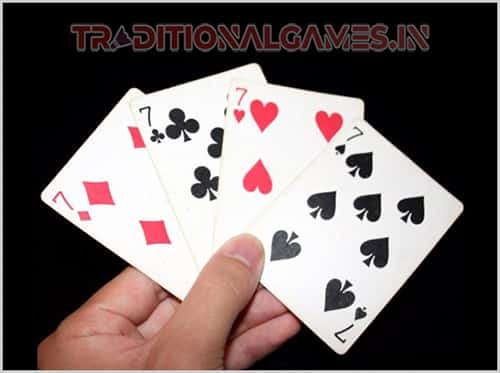
- Players: The game is typically played with a standard deck of 52 cards and requires at least two players.
- Dealing of Cards: The entire deck of cards is shuffled, and each player is dealt a specific number of cards, depending on the number of players. For example, if there are four players, each player may receive seven cards.
- Objective: The objective of the game is to get rid of all the cards in your hand by playing them in sequences or sets.
- Gameplay: The player with the seven of hearts (7♥) starts the game by placing it face-up on the table. The game then proceeds clockwise.
- Play: Each player takes turns playing a card that matches either the suit or the rank of the card previously played. For example, if the seven of hearts is played, the next player can play a card with the same suit (hearts) or the same rank (seven) from their hand.
- Sequences and Sets: Players can play cards in sequences (consecutive cards of the same suit) or sets (cards of the same rank). For example, a sequence could be 4♥-5♥-6♥, and a set could be 10♣-10♠-10♦.
- Skipping Turns: If a player cannot play a card that matches the suit or rank, they must skip their turn and wait for their next opportunity to play.
- Winning: The first player to get rid of all their cards is declared the winner of the round. The game may consist of multiple rounds, and the player with the fewest points at the end of all the rounds is considered the overall winner.
Satte pe satta (Dominoes, Tan Fan, or Parliament) is a game that offers enjoyable gameplay and is often played for entertainment among friends and family.
Real Cricket Latest version Release date
How to Play Satte pe Satta?
In the game of Satte pe Satta, played with 3 to 8 players using a standard deck of 52 cards, here are the key rules and gameplay:
- Number of Players: 3 to 8 players participate in the game.
- Dealing of Cards: The number of cards dealt to each player may vary in different rounds. The cards are dealt face down.
- Card Arrangement: Each player must arrange their cards in the order of suits: Hearts, Clubs, Spades, and Diamonds.
- Starting Card: The game begins with a player laying the 7 of Hearts on the table. Any player who possesses the 7 of Hearts can start the game.
- Sequence Building: Players have to create a sequence by laying out the cards in ascending order till the ace of Hearts. The sequence follows the ranks: K, Q, J, 10, 9, 8, 7, 6, 5, 4, 3, 2, A.
- Game Progression: The game progresses in a clockwise direction. The player who possesses the next card in the sequence (e.g., 6 or 8 of Hearts) lays it down.
- Passing Turn: If a player does not possess the next card in the sequence or the sevens of any suit, they have to say “Pass” and pass the turn to the next player.
- Card Usage and Winner: The game continues until a player uses up all the cards in their hand. The player who exhausts all their cards is declared the winner.
- Score Calculation: The losing players’ scores are calculated based on the cards remaining in their hands.
How to Win in Satte pe Satta Game (Best Tips & Tricks)
To increase your chances of winning in Satte pe Satta, here are some tips and tricks to consider:
- Plan your Card Arrangement: Arrange your cards strategically in the order of suits to facilitate quick and efficient sequence building. This will help you lay down cards in sequence promptly and gain an advantage over other players.
- Track Played Cards: Pay close attention to the cards played by other players. This will allow you to deduce which cards are still in play and plan your moves accordingly. Keep track of the sequence and anticipate the upcoming cards to make informed decisions.
- Preserve Essential Cards: Identify the crucial cards required to complete sequences and retain them in your hand for as long as possible. By doing so, you can prevent opponents from forming complete sequences and increase your chances of winning.
- Timing of Passes: Be strategic in when you choose to pass. If you have a limited number of cards left, consider passing when the sequence reaches a point where you won’t be able to play your remaining cards. This can prevent you from accumulating higher penalty points.
- Observe Opponents: Watch how other players are arranging and playing their cards. Look for patterns, strategies, and their attempts to complete sequences. This information can help you make better decisions, anticipate their moves, and plan your own moves accordingly.
- Control Emotions: Keep your emotions in check during the game. Avoid showing frustration or excitement as it may provide cues to other players about your cards and strategies. Maintain a calm and composed demeanor to keep your opponents guessing.
- Strategic Card Play: Use your cards strategically by analyzing the sequence progression and considering the potential cards that can be played. Make calculated moves to disrupt opponents’ sequences or build your own.
- Risk Assessment: Evaluate the risks involved in playing specific cards. Sometimes, holding onto cards for longer can be beneficial if the probability of completing a sequence is higher. Assess the potential gains and losses before playing a card.
- Adapt to Changing Circumstances: Be flexible in your strategy and adapt to the changing dynamics of the game. Assess the cards in play, your opponents’ moves, and adjust your gameplay accordingly to maximize your chances of winning.
Remember, Satte pe Satta is a game that combines luck and strategy. While luck plays a significant role, employing these tips and tricks can enhance your gameplay and improve your chances of winning.
Donkey
Donkey, also known as Pig, is a fun and simple card game often enjoyed by children. Here’s an overview of how the game is played:

Objective
The objective of Donkey is to collect a quartet, which consists of four cards of the same rank. The goal is to be the first player to collect a quartet and touch your nose. The player who touches their nose last is considered the “donkey” and may be subjected to a penalty or designated as the loser of the game.
Setup
To play Donkey, you’ll need a standard deck of 52 playing cards.
Gameplay
- The cards are shuffled and dealt evenly among all the players.
- Players then look at their cards and try to form quartets by collecting four cards of the same rank (e.g., four Aces, four Queens, etc.). It is important to keep the cards you collect hidden from the other players.
- The game begins with the starting player asking any opponent for a specific rank of card that they need to complete a quartet. For example, if a player has three Queens, they can ask another player, “Do you have a Queen?”
- The player must only ask for a card they do not currently have in their hand.
- If the player asked has the requested card, they must give it to the asking player.
- If the player asked does not have the requested card, they say, “Go Fish!” and the asking player must draw a card from the deck.
- If the drawn card matches the rank the player was seeking, they can place it with their collected cards to form a quartet.
- Play proceeds to the next player, and the process continues until a player collects a quartet.
- The player who collects a quartet must touch their nose discreetly or subtly to indicate that they have completed it.
- The last player to touch their nose after someone else has made a quartet is considered the “donkey” of the game.
Penalties and Variation
In some versions of the game, the “donkey” may be subject to a penalty, such as performing a silly task or providing a treat to the other players. However, the exact penalties or consequences can vary depending on the rules established by the players.
Donkey (or Pig) is a lighthearted and amusing game that can bring joy and laughter to gatherings or playtime with children. It’s a game of luck and observation, as well as a test of memory as players try to remember which cards have been collected by others. Enjoy the playful nature of the game and have fun!
Bluff
Bluff, also known as Bull****, BS, or Cheat, is a card game that revolves around bluffing your opponents. The objective is to get rid of all your cards by playing them in a way that may or may not adhere to the rules.
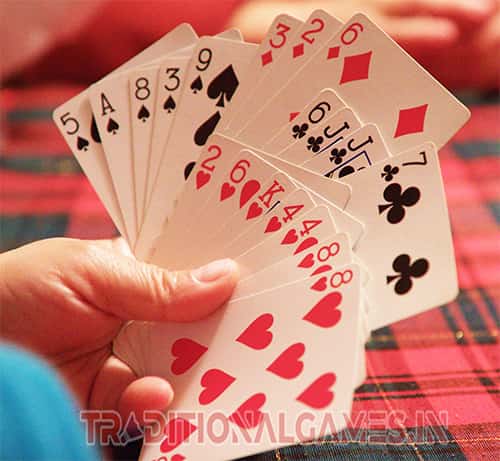
How to Play Bluff
Number of Players: 3 to 10 players
Deck: Standard deck of 52 cards (no Jokers)
- Cards are shuffled and dealt to each player.
- A leader is chosen to start the game and announces the rank to be played.
- The leader places one or more cards face-down at the center of the table.
- The player to the left of the leader plays a trick by placing cards of the announced rank face-down.
- Other players can choose to pass and not participate further in the current deal, or challenge the cards played by calling bluff.
- If a player challenges, the cards played are revealed. If they match the announced rank, the challenger picks up the center pile. Otherwise, the player who played the wrong cards picks up the pile.
- If all players pass, the cards on the table are cleared, and the player who played the last card becomes the new leader for the next deal.
- The game continues with the new leader announcing the next rank to be played.
- The game ends when a player successfully gets rid of all their cards.
- The player who gets rid of all their cards first is declared the winner of the game.
Bluff Card Game involves a mix of strategy, bluffing, and observation. Players aim to deceive their opponents by playing cards of the announced rank while potentially bluffing their way to success. It can be an engaging and enjoyable game that tests players’ ability to read their opponents and take calculated risks.
How to Win in Bluff?
- Maintain a Straight Face: To deceive your opponents, it’s crucial to keep a straight face and avoid displaying any signs of lying or bluffing. This will make it harder for others to catch on to your tactics.
- Plan Your Game: Before playing your cards, preplan your moves. Consider the sequence of cards you want to play and arrange your cards accordingly. Having a strategy in mind can help you execute your bluff effectively.
- Play Four Different Cards with Four of a Kind: If you have a four-of-a-kind hand and it’s your turn to play, opt to play four different cards instead of all four of the same rank. This can create confusion and make it less likely for others to challenge your play.
- Keep Track of Played Cards: Pay attention to the cards that have been played by other players. Keep a mental count of the cards to help you identify when someone is bluffing. By calling out “BS” when you believe someone is bluffing, you can potentially expose their deception and gain an advantage in the game.
By incorporating these strategies into your gameplay, you can enhance your chances of success in the Bluff Card Game. Remember to adapt your tactics based on the specific circumstances and your opponents’ behavior. Enjoy the game and the thrill of outsmarting your fellow players!
Variations of Bluff
- British Variant: In the British variant of Bluff, players have the option to pass their turn if they don’t want to bluff or if all the cards have been played before. This allows players more flexibility in their gameplay strategy.
- Variations in Rank Calling and Discarding: Some versions of Bluff allow players to call either higher or lower ranks during their turn, expanding the range of possible plays. Additionally, certain variants may require players to discard one card during their turn, adding an additional element of decision-making to the game.
- Lying About the Number of Cards: In certain variations of Bluff, players are allowed to lie about the number of cards they are playing. This introduces an extra layer of deception and bluffing, making the game more challenging and unpredictable.
These international variations add unique twists and rules to the basic concept of the Bluff Card Game. Exploring different variations can bring diversity and excitement to your gameplay. Remember to familiarize yourself with the specific rules of the variant you are playing to fully enjoy and adapt your strategies accordingly. Have fun experimenting with these variations and discovering new aspects of the game!
Mendikot
Mendikot, also known as Mendicot, is a popular trick-taking card game that originated in India. It is particularly beloved in the states of Maharashtra and Gujarat. The name “Mendikot” is derived from the Gujarati words “mendi,” which means zero (referring to the card rank 10), and “kot,” which means victory.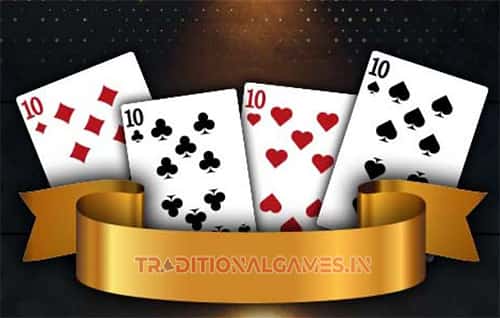
Objective
The objective of Mendikot is to collect the highest number of 10s among the cards played during the game.
How to Play Mendikot?
Number of Players: 4 players divided into two pairs/teams. Partners sit opposite each other.
Number of Decks: 1 standard deck of cards.
Card Ranks: A, K, Q, J, 10, 9, 8, 7, 6, 5, 4, 3, 2 (from highest to lowest).
Dealing: A dealer is chosen, and the dealer deals 13 cards to each player. Initially, 5 cards are dealt to each player, and the remaining cards are dealt later. The trump suit is determined using one of the following methods:
- Player’s Choice: The player to the right of the dealer draws the first card and reveals it to the other players. The suit of that card becomes the trump suit for the deal.
- Closed Trump: The player to the right of the dealer draws a card from the deck and places it face down on the table. The suit of that card becomes the trump suit.
- Cut Trump: The game begins without a predetermined trump suit. If a player is unable to follow the suit led by the first player, the suit of the card played to continue the trick becomes the trump suit.
Play
The player to the right of the dealer leads the first trick by playing any card. Other players must follow the suit if possible; otherwise, they can play any card. The player with the highest-ranking card of the led suit or the highest-ranking trump card wins the trick. The winner collects the played cards and leads the next trick.
Scoring
The objective is for a team to collect three or four 10s in a trick. If both teams have two 10s, the team that has won seven or more tricks is the winner. If a team manages to collect all four 10s in a trick, it is called a “mendikot.”
How to Win in Mendikot?
To increase your chances of winning in Mendikot, here are some tips and strategies to consider:
- Collecting 10s: The primary objective of Mendikot is to collect the highest number of 10s. Keep an eye on the 10s that have been played and try to win tricks that contain 10s. Strategize with your partner to maximize your chances of capturing these valuable cards.
- Trump Suit Management: Understanding and effectively managing the trump suit is crucial. If you have control over choosing the trump suit, select a suit that you have a good number of high-ranking cards in, preferably with 10s. This gives you a better chance of winning tricks and collecting more 10s.
- Card Counting: Pay attention to the cards that have been played in each trick. This will help you gauge which high-ranking cards are still in play and which suits are likely to be strong. Card counting can give you an advantage in decision-making and predicting your opponents’ moves.
- Communication and Partnership: Mendikot is played in partnerships, so effective communication with your partner is vital. Share information about the cards you hold, especially if you have strong cards or 10s. Coordinate your plays and strategies to maximize your team’s chances of winning tricks and collecting 10s.
- Strategic Play: Be mindful of the cards you play during each trick. Try to hold onto high-ranking cards, especially if they have a good chance of winning the trick. Sometimes, strategically losing a trick by playing lower-ranking cards can help set up future tricks to your advantage.
- Observation and Analysis: Observe the plays and patterns of your opponents. Analyze their strategies and tendencies to anticipate their moves and plan your own moves accordingly. This can help you make informed decisions and increase your chances of winning tricks and collecting 10s.
Remember that Mendikot is a game of both skill and luck. While these strategies can improve your gameplay, luck also plays a significant role. Stay adaptable, adjust your strategies based on the changing game dynamics, and enjoy the strategic challenges and excitement that Mendikot offers.
Variations of Mendikot
In Dehla Pakad, a variation of mendikot, the game is played by six to eight players in two teams of equal size. All 2s are removed from the deck, and the remaining cards are dealt equally. The only difference from mendikot is that when a player wins two tricks in a row, they can collect them and keep them face down.
Can anyone teach me how to play card games by themselves without help from someone else?
While learning card games by yourself can be challenging, it is possible to teach yourself how to play through various resources. Here are some steps you can follow:
- Obtain a rulebook or guide: Look for rulebooks or guides for the specific card game you want to learn. These resources can provide instructions, gameplay examples, and strategies.
- Online tutorials and videos: Search for online tutorials and videos that demonstrate how to play the card game you’re interested in. Many websites and platforms offer step-by-step guides and visual demonstrations.
- Mobile apps and computer programs: Some card games have dedicated mobile apps or computer programs that can help you learn and play. These applications often include tutorials, practice modes, and AI opponents to play against.
- Practice with virtual opponents: Utilize computer programs or online platforms that offer virtual opponents to play against. This allows you to practice and familiarize yourself with the game’s mechanics and strategies.
- Join online communities and forums: Participate in online communities and forums dedicated to the card game you’re learning. Engage with experienced players, ask questions, and seek advice to enhance your understanding of the game.
- Play solo variants: Many card games have solo variants designed specifically for individual play. These variants often have modified rules or special setups to accommodate solo play. Look for solo gameplay rules or variants for the card game you’re interested in.
Remember that practice is crucial when learning a new card game. It may take time to grasp the rules and develop strategies, but with persistence and dedication, you can become proficient at playing card games on your own.
FAQs
What is the most popular card game in 2024?
Poker is a widely enjoyed card game globally, cherished by millions of fans. It offers not only entertainment but also provides a stimulating mental exercise.
What is the No 1 card game?
The World's #1 Card Game is UNO!
What are the top 10 best card games?
Uno: A card game suitable for players of all ages, offering universal appeal. Apples to Apples: An excellent choice for parties, fostering lively and engaging gameplay. Cards Against Humanity: Geared towards adults, this game embraces irreverent humor and creativity. Kids Against Maturity: Designed specifically for children, providing age-appropriate fun and entertainment. Exploding Kittens: A strategic game that combines luck and planning, offering an engaging and competitive experience. Sushi Go!: A quick-paced game that challenges players' decision-making skills, centered around collecting sushi cards. Gloom: A card game known for its dark humor and storytelling, appealing to those with a taste for the macabre. Marvel Champions: The Card Game: Perfect for team play, allowing players to take on the roles of superheroes and collaborate. Arkham Horror: The Card Game: A horror-themed game that immerses players in an eerie world filled with mysteries and suspense. Five Crowns: Putting a unique twist on traditional playing cards, this game adds new elements and strategies for an enjoyable experience.
What is the oldest card game?
Karniffel is a card game that evolved from the original Karnöffel, which originated in Bavaria in the early 15th century. It holds the distinction of being the oldest known European card game in history.
Related Posts
- Roblox Dead Realm Redeem Codes
- Roblox Fish Sim Today Redeem Codes
- Mission Zero Redeem Codes
- Roblox Nightmares Redeem Codes
- Era Of Glory Redeem Codes
- Roblox Jailbreak Redeem Codes
- Tower Of God Great Journey Redeem Codes
